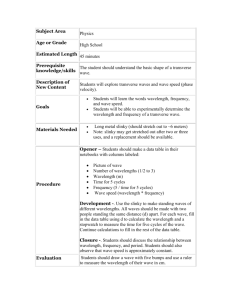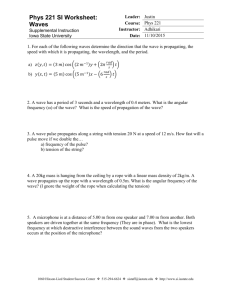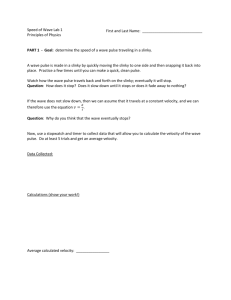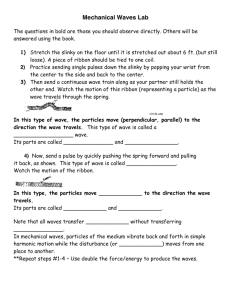Slinky and Snaky Wave Lab Activity
advertisement
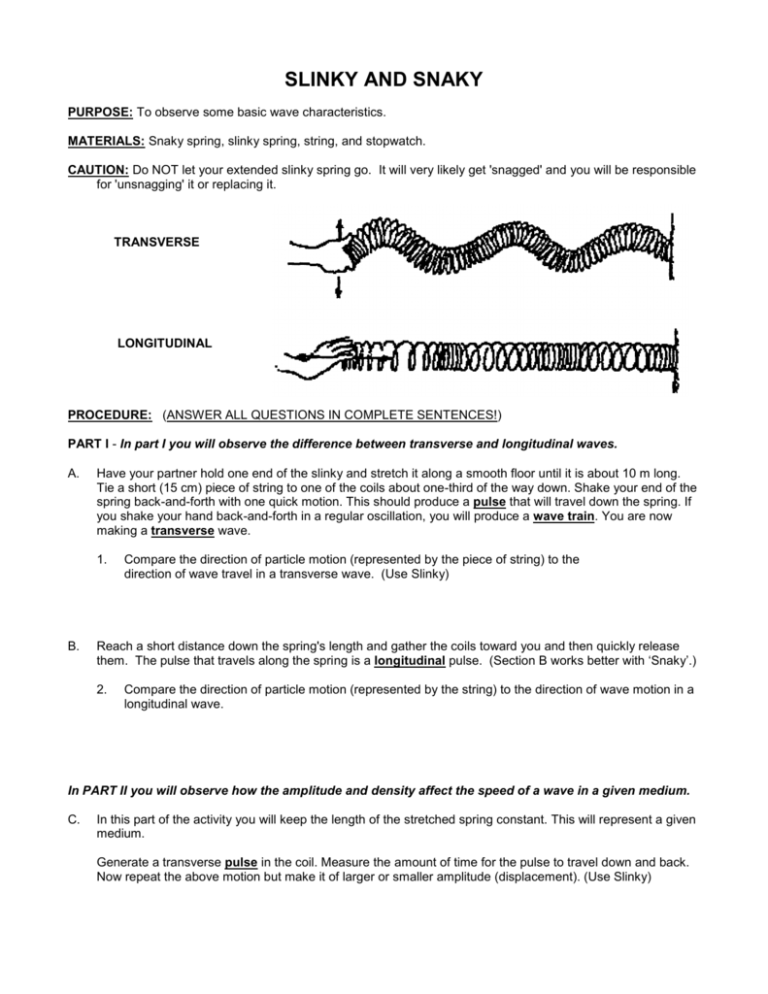
SLINKY AND SNAKY PURPOSE: To observe some basic wave characteristics. MATERIALS: Snaky spring, slinky spring, string, and stopwatch. CAUTION: Do NOT let your extended slinky spring go. It will very likely get 'snagged' and you will be responsible for 'unsnagging' it or replacing it. TRANSVERSE LONGITUDINAL PROCEDURE: (ANSWER ALL QUESTIONS IN COMPLETE SENTENCES!) PART I - In part I you will observe the difference between transverse and longitudinal waves. A. Have your partner hold one end of the slinky and stretch it along a smooth floor until it is about 10 m long. Tie a short (15 cm) piece of string to one of the coils about one-third of the way down. Shake your end of the spring back-and-forth with one quick motion. This should produce a pulse that will travel down the spring. If you shake your hand back-and-forth in a regular oscillation, you will produce a wave train. You are now making a transverse wave. 1. B. Compare the direction of particle motion (represented by the piece of string) to the direction of wave travel in a transverse wave. (Use Slinky) Reach a short distance down the spring's length and gather the coils toward you and then quickly release them. The pulse that travels along the spring is a longitudinal pulse. (Section B works better with ‘Snaky’.) 2. Compare the direction of particle motion (represented by the string) to the direction of wave motion in a longitudinal wave. In PART II you will observe how the amplitude and density affect the speed of a wave in a given medium. C. In this part of the activity you will keep the length of the stretched spring constant. This will represent a given medium. Generate a transverse pulse in the coil. Measure the amount of time for the pulse to travel down and back. Now repeat the above motion but make it of larger or smaller amplitude (displacement). (Use Slinky) 3. D. What do you observe regarding the amplitude of a pulse and its speed in a given medium? Without changing the distance between the two people holding the spring, ‘bunch-up’ part of the spring in each person’s hand, so that the spring is stretched more. Send a transverse pulse down this stretched spring and time it. 4. What do you observe about changing the ‘density’ of the spring and the speed of waves that travel down the spring? In PART III, you will observe how the frequency of a wave affects its speed and wavelength. E. Generate waves of different frequencies and observe how the speed of the wave changes as the frequency changes. (Generate three waves - Use Slinky) 5. F. What do you observe regarding the frequency of a wave and its speed in a given medium? Shake the spring back-and-forth rapidly (at a high frequency) to generate wave trains in a spring. Observe the wavelength. The wavelength of the wave is the distance from one crest to the next crest. Shake the spring back-and-forth slowly (at a low frequency) and observe the wavelength. 6. What do you observe regarding the frequency of a wave and its wavelength? In Part IV, you will observe what happens when two pulses which are traveling in opposite directions in a spring meet. Use Slinky. G. H. Have your partner grasp one end of the spring while you grasp the other end. Send pulses toward each other on the same side of the spring at the same time. Try this and observe the pulses when they come together and after they pass through one another. Try pulses of the same and different amplitudes. Observe what happens. 7. Describe what happened when two pulses meet on the same side of the spring. 8. Describe the shape of the two pulses after the 'collision' as compared to their shape before. Repeat the above procedure, except this time each partner should send the pulses down opposite sides of the spring. Observe what happens when they are of the same amplitude. 9. Describe what happens when two pulses of equal magnitude moving toward each other on opposite sides of the spring meet. 10. Describe the shape of the two pulses after the 'collision' as compared to their shapes before the collision. PART V - In part V you will observe what happens to a pulse when it is reflected from an object. I. For this part of the experiment use the snaky spring rather than the slinky spring. Have your partner hold one end of the spring firmly. The other partner should send a transverse pulse down the spring. Observe whether the pulse is reflected back on the same side or on the opposite side of the spring. 11. Describe how a pulse is reflected from a rigid (denser) medium. J. Tie a piece of thread 2-m long to one end of the spring. One partner should hold the thread while the other partner sends a pulse toward the end supported by the thread. This part of the activity will work best if the spring is not stretched too much. (The thread represents a less rigid medium.) Observe whether the reflected pulse returns on the same side or on the opposite side of the spring. 12. Describe how a pulse is reflected from a less rigid medium. PART VI - In this part of the activity you will observe what happens to a wave's characteristics (velocity, wavelength, amplitude) when it passes from one medium into another. The two mediums you will use are represented by the two different springs. K. Connect the slinky with the snaky. (You may want to use masking tape.) Stretch the slinky as before. Have your partner hold the end of the snaky while you hold the end of the slinky. Send pulses and short waves down the slinky spring. Observe what happens when it reaches the boundary. 13. When a wave reaches a boundary between two mediums, part of it is ____________________ while part of it is ____________________. 14. When a wave goes from a less dense medium to a denser medium (as above), the wavelength _________________ and the velocity __________________. 15. When a wave goes from a less dense medium to a denser medium, the frequency ________________. L. Send short pulses and waves down the snaky spring and observe what happens when they reach the slinky spring. 16. When a wave goes from a denser medium to a less dense medium ____________________ of it is transmitted than in the reverse case. 17. When a wave goes from a denser medium to a less dense medium, the wavelength ______________ and the velocity ____________________. 18. When a wave goes from a denser medium to a less dense medium, the amplitude _______________.
